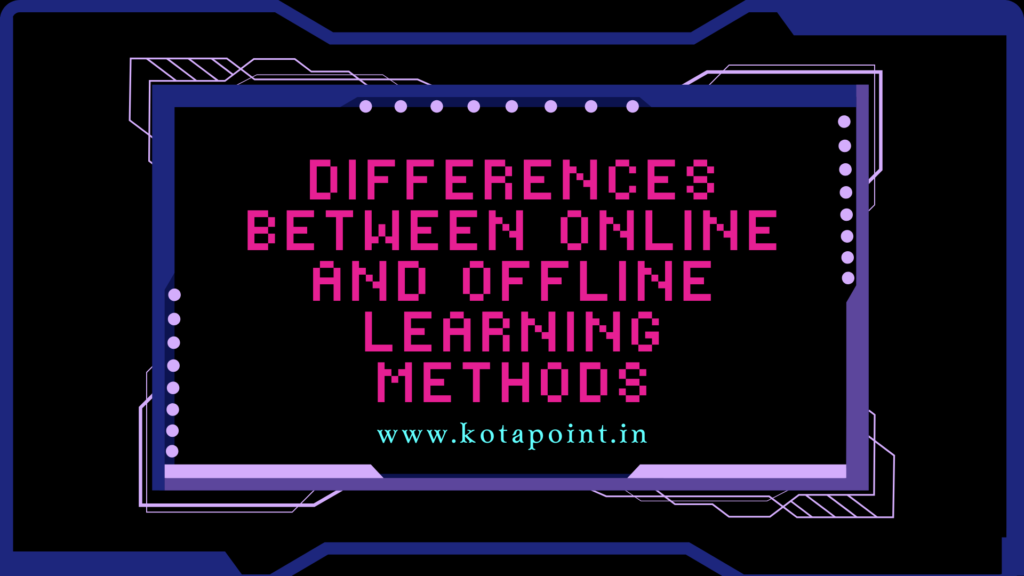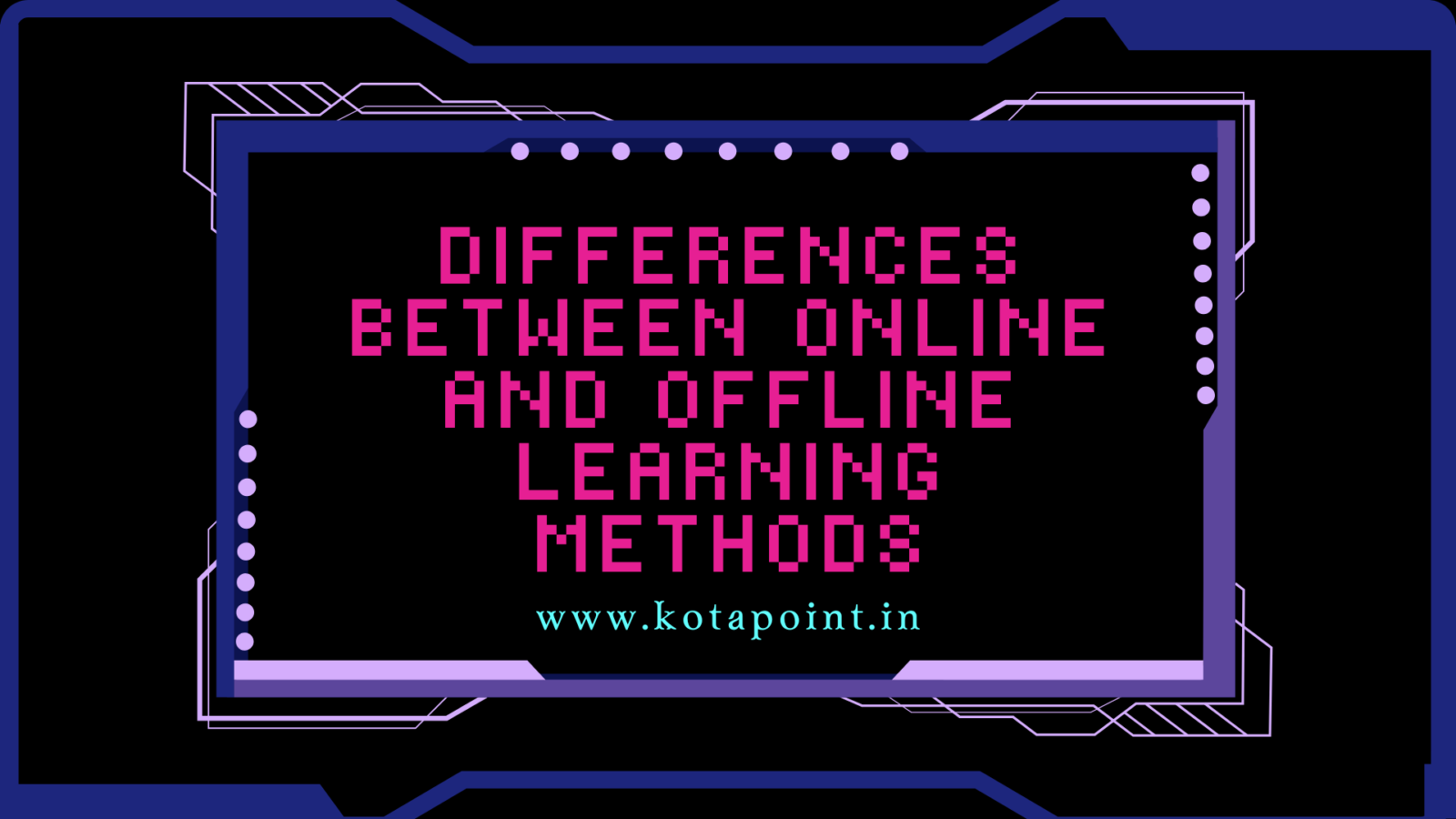As education evolves, students are increasingly weighing the differences between online and offline learning methods to determine which approach suits them best. Both online learning and offline learning offer unique advantages, but they also have notable distinctions that cater to different learning styles, schedules, and educational goals. In this article, we’ll explore the key differences between online and offline learning methods, focusing on the benefits, drawbacks, and potential outcomes of each to help students make an informed choice.

What is Online Learning?
Online learning is a method where educational content is delivered digitally. Through online learning platforms or virtual classrooms, students access lectures, assignments, and interactive sessions remotely. With the rise of technology, online learning has gained immense popularity due to its flexibility and convenience, especially for those who prefer studying from home or have busy schedules.
What is Offline Learning?
Offline learning, often referred to as traditional classroom learning, is conducted in physical spaces like schools, colleges, and training centers. In offline learning, students engage with instructors face-to-face, participate in discussions, and benefit from a structured environment that encourages immediate feedback and hands-on experience.
Key Differences Between Online and Offline Learning Methods
1. Flexibility and Convenience
One of the most notable differences between online and offline learning is the flexibility that online platforms provide. Online learning allows students to access materials and complete assignments at their own pace, making it an ideal choice for working professionals or those with other commitments. In contrast, offline learning operates on a fixed schedule, requiring students to adhere to a specific timetable, which can be beneficial for individuals who thrive in structured environments.
2. Interaction and Engagement
Interaction levels differ significantly in online and offline learning methods. In offline learning, students interact directly with instructors and peers, fostering a social and collaborative learning environment. This face-to-face interaction is valuable for building relationships and enhancing engagement. Conversely, online learning primarily relies on virtual communication through discussion forums, video calls, or chat functions, which can limit the depth of interaction and make it challenging for some learners to stay engaged.
3. Accessibility and Cost
Online learning methods are accessible from anywhere, provided the student has a reliable internet connection and a compatible device. This accessibility is especially beneficial for students in remote areas or those who cannot commute. Additionally, online learning is often more affordable than offline learning due to lower operational costs. Offline learning, however, often involves additional costs for transportation, accommodation, and course materials, which may be challenging for some students.
4. Learning Environment
The learning environment varies significantly between online and offline methods. Offline learning takes place in a classroom setting with a structured routine, which can be motivating for students who benefit from a disciplined environment. Online learning, on the other hand, allows learners to study in their preferred environment, whether at home or a local library. However, the lack of a structured environment in online learning can lead to distractions and lower motivation for some individuals.
5. Self-Discipline and Time Management
In online learning methods, students must manage their time effectively and stay self-disciplined, as they often learn independently without direct supervision. For some, this encourages the development of critical skills like self-motivation and time management. In offline learning, the presence of instructors and a set schedule helps students maintain a disciplined approach to their studies, which can be advantageous for those who find it challenging to stay focused on their own.
6. Hands-On Learning Opportunities
Practical learning is another area where online and offline learning methods differ. Offline learning is well-suited for subjects that require hands-on activities, such as laboratory work, field trips, and physical projects, where students can learn through direct experience. In online learning, however, practical opportunities are often limited to simulations or virtual labs, which may not provide the same level of hands-on experience as in-person activities.
7. Technological Requirements and Skills
Online learning relies heavily on technology, necessitating a stable internet connection and a certain level of digital literacy. Students need to be comfortable using digital platforms, managing virtual assignments, and participating in online discussions. In offline learning, these technological requirements are minimized, as traditional teaching methods are used, allowing students to focus entirely on the content without technical distractions.
Pros and Cons of Online Learning
Pros:
- Flexibility to study at any time and place
- Lower costs and fewer associated expenses
- Access to a wide range of resources and materials
Cons:
- Limited hands-on experience
- Potential for distractions and lack of motivation
- Less face-to-face interaction
Pros and Cons of Offline Learning
Pros:
- Structured environment promotes discipline
- Enhanced interaction with instructors and peers
- Greater opportunities for practical, hands-on experience
Cons:
- Fixed schedules may limit flexibility
- Higher costs due to transportation and accommodations
- Less accessible for remote learners
Conclusion:
Understanding the differences between online and offline learning methods can help students choose a learning style that aligns with their needs and goals. Online learning is ideal for students who prioritize flexibility and cost-effectiveness, while offline learning is beneficial for those who value structure, face-to-face interaction, and hands-on experiences. Ultimately, the best choice depends on personal preferences, career objectives, and individual learning styles.
Frequently Asked Questions (FAQs)
What are the main differences between online and offline learning methods?
The main differences between online and offline learning methods include flexibility, interaction levels, accessibility, and the learning environment. Online learning offers more flexibility and lower costs, while offline learning provides more structured interaction and hands-on learning opportunities.
Which is more effective, online learning or offline learning?
The effectiveness of online and offline learning methods depends on the learner’s preferences. Online learning suits self-disciplined individuals who value flexibility, while offline learning is effective for students who prefer structured schedules and in-person engagement.
What are the benefits of online learning?
Online learning offers flexibility, cost savings, and access to a variety of resources. It is ideal for students with busy schedules or those who live far from educational institutions.
How does offline learning help in practical subjects?
Offline learning excels in practical subjects by providing hands-on experiences and in-person supervision, which are difficult to replicate in online learning methods.















Leave a Reply